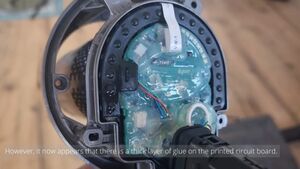Please note that all submissions to the site are subject to the wiki's licence, CC 4.0 BY-SA, as found here
Dyson: Difference between revisions
Arduino, not Pi |
added stub notice |
||
| Line 1: | Line 1: | ||
{{StubNotice}} | |||
Dyson is a manufacturer of vacuum cleaners. | Dyson is a manufacturer of vacuum cleaners. | ||
Revision as of 10:20, 16 January 2025
❗Article Status Notice: This Article is a stub
This article is underdeveloped, and needs additional work to meet the wiki's Content Guidelines and be in line with our Mission Statement for comprehensive coverage of consumer protection issues. Issues may include:
- This article needs to be expanded to provide meaningful information
- This article requires additional verifiable evidence to demonstrate systemic impact
- More documentation is needed to establish how this reflects broader consumer protection concerns
- The connection between individual incidents and company-wide practices needs to be better established
- The article is simply too short, and lacks sufficient content
How You Can Help:
- Add documented examples with verifiable sources
- Provide evidence of similar incidents affecting other consumers
- Include relevant company policies or communications that demonstrate systemic practices
- Link to credible reporting that covers these issues
- Flesh out the article with relevant information
This notice will be removed once the article is sufficiently developed. Once you believe the article is ready to have its notice removed, visit the Discord (join here) and post to the #appeals channel, or mention its status on the article's talk page.
Dyson is a manufacturer of vacuum cleaners.
Battery packs lacking cell balancing, featuring self-bricking firmware
Dyson battery packs contain a Battery Management System (BMS) with a chip that would be capable of balancing the individual cells. However, the manufacturer has decided to leave away a few inexpensive but essential resistors, resulting in no balancing to take effect. As a result, the battery pack wears out much quicker than necessary.
After just a few years, spare battery packs are "out of stock" (e.g., the Dyson V8 SV10 Battery being currently unavailable in Germany), effectively suggesting that the device should be thrown away.
Even if one charges (using a third-party charger) and balances, or even replaces the individual cells, the Battery Management System will still not allow you to charge the battery because its firmware writes 2 bytes into the configuration memory of the microcontroller that essentially bricks the battery pack. However, third-party open source firmware has been written to replace the proprietary firmware for some models, and for some models it has been found out which configuration bits need to be changed in order to un-brick the battery pack[1][2]. This has been covered in the (specialist) media[3].
This anti-consumer and anti-repair pattern can be observed across multiple models and product iterations, and appears to be fully intentional.
Open source software has been written to un-brick the battery pack by overwriting the configuration bits for some models using a 3.3V Arduino board[4].
Harder to repair buttons

There have been reports of vacuum trigger button being harder to self-repair for a consumer due to the use of glue on the PCB, prompting the user to replace the whole housing.[5][6]
References
- ↑ https://github.com/tinfever/FU-Dyson-BMS
- ↑ https://github.com/davidmpye/V10_Dyson_BMS
- ↑ https://hackaday.com/2022/05/23/fighting-back-against-dodgy-dyson-batteries/
- ↑ https://github.com/kumdzio/PIC16LF1847arduino-programmer/tree/main/Dyson_original_firmware_unlocker_with_eeprom_check
- ↑ 5.0 5.1 https://www.youtube.com/watch?v=KF0nNOAFnRQ
- ↑ https://www.youtube.com/watch?v=cUqfrIk-FhM; Dyson's repair procedures suck, unlike their vacuums#2022